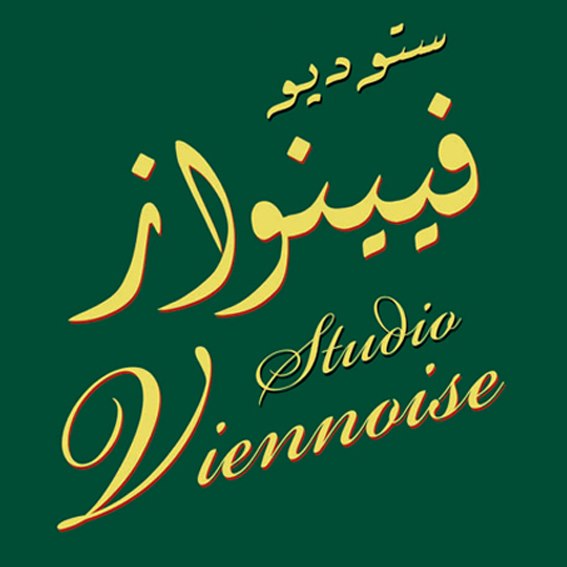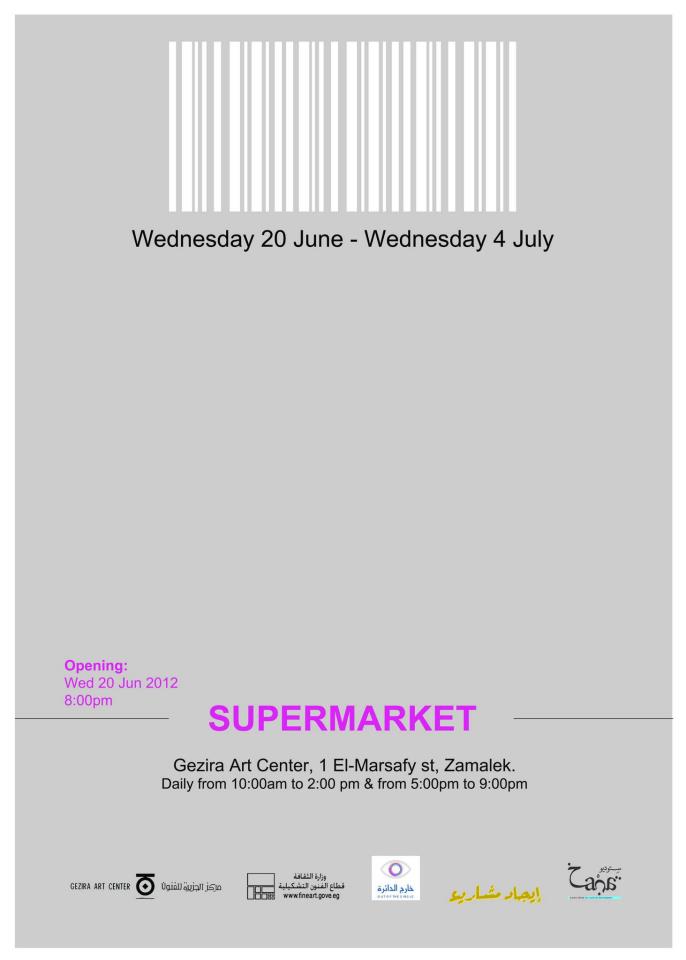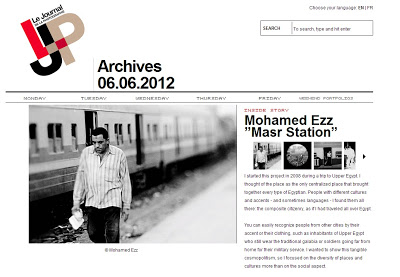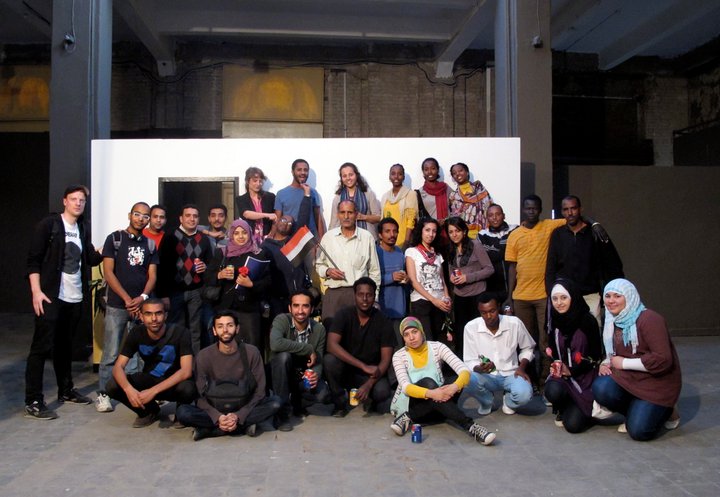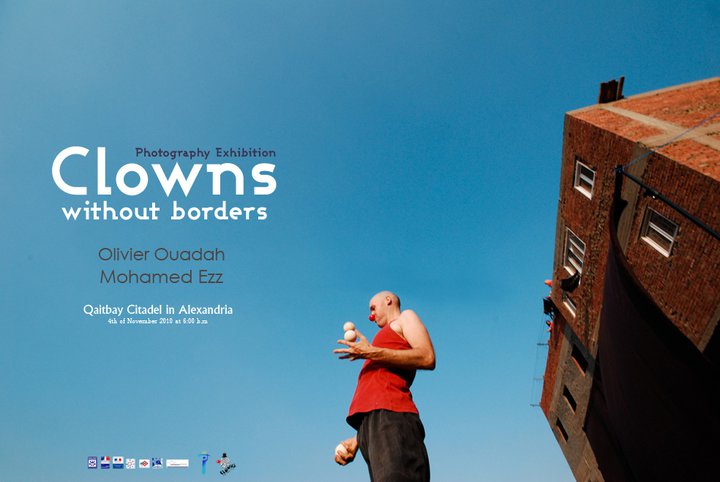
Scroll down for the original German version
English version:
The title of the exhibition is “turning points“. What kind of turning point do you experience right now in Egypt?
Actually it has been more than two and half years of successive turning points since the revolution. The last turning point we’re experiencing right now is the overthrowing of the government of Mohamed Morsi by the army and reliving the interim period until we can make another presidency and parliament elections.
The fotos of „The Other Faces of Morsi“ (2012) are quite political and are shown for the first time in Biel. Would it have been possible for you to show them in Kairo?
I had prepared the work to be shown in Cairo during the time of Mohamed Morsi, but unfortunately I couldn’t find an appropriate chance to show it, and currently, I do not think it will have any meaningful value to be shown in Cairo after the overthrowing of Morsi.
Didn‘ t you have fear to show the fotos of Morsi in Kairo?
I do not have any fears to show the photos in Cairo. I only couldn’t find an appropriate chance to show them. As you know, the art scene in Cairo has been badly affected by the unstable situations.
Moreover, the work is related to a certain turning point that already gone. So as I mentioned, I do not think it will have any meaningful value to be shown again in Cairo specially these days.
How did you experience the year of Mohammed Mursi Isa al-Ayyat as president?
Let’s first say that the Egyptians’ ambitions were very high after the revolution and the fast escalation of events made them expect fast achievements as well. At the same time, Egypt was facing great financial problems due to losses in tourism and foreign investments. The Muslim Brotherhood joined the race for presidency (with Mohamed Morsi as their candidate) after promising the people with a great project that will solve all the problems in Egypt called “The Renaissance Project”. Morsi won the elections and people started to wait for these great achievements, but all they found was failures.
At the same time, Morsi could not reassure the average Egyptian person or commit to an unbiased political speech that enforces the people’s trust in him as a president for all Egyptians and not a president for one specific religious group.
Morsi did not succeed in anything but making more enemies from all the sectors in the country and from politicians and intellectuals who had supported him previously, which led to a cooperation between all those groups to get rid of him in the demonstrations of June the 30th.
What religion do you have and how important is it to you?
If you are suggesting that my opinion is affected with my religion, I want to mention that my opinions are strictly logical and not related to my religious background.
How did you feel the last months in Kairo ?
I feel that most of the Egyptians have decided to become more pragmatic and support the military to go back to their stable and secure lives they had before. And the current authority is trying to take back control of all the institutions of the country and enforce security to reassure the people after refusing to protect them previously.
Did you feel secure in Kairo in the last days of Morsi?
For me, my disappointment was stronger than my fear. During the clashes, I used to avoid the hostile areas, so I didn’t have big problems living my normal life, but I no longer enjoy the streets of Cairo like I did before.
What has changed in Kairo since the revoultion of 2011?
The shape of the city was already changing gradually. But after the revolution system and security have been affected very dramatically, traffic was a real problem due to street sellers who has spreaded on the streets, non-licensed cheap motorcycles driven by young boys and even tok-tok can be seen on the main streets. The slum culture was spreaded from poor slums around Cairo to the center of the city.
The freedom of opinion is officially guaranteed. Are you really free to express yourself – in private or as an artist ?
Usually I feel free to express myself and my thoughts without problems specially after the revolution, since freedom of speech has become an acquired right. I just had one accident recently regarding this exhibition when I tried to send the photos through a shipping company and the airport security refused to send the package.
I do not know if the recent changes will affect the freedom of speech, but I can see that almost all of the Egyptian media is reflecting only one point of view and they avoid presenting or inviting other people who might be having an opposing view.
In what way do you feel, that the media show only one point of view?
Most of media -and normal people- believe that military is the only hope for the country to survive, and supporting them careless of violation probabilities of human rights is an exception period to save the country from terrorism, so they become less critique to their mistakes unlike their focusing on criticizing Morsi’s behaviors in the time of his presidency.
Why couldn‘ t you come to Switzerland for the opening of your exhibition?
I was busy at work recently, so I couldn’t prepare for the trip. It was also hard for me to afford the flight tickets.
What do you think of the USA and the „cowboy“ Barack Obama?
Obama is like the other former presidents of USA. He acts as the guard of democracy, liberty and human rights in the whole world, but he’s actually working on protecting his country’s interests and maintaining benefits with his allies, while keeping control on the regimes of the Middle East and the energy resources in it, and also keeping high popularity for himself and his party among Americans. So it doesn’t matter if he supports a dictatorship or becomes a friend with non democratic regimes, and it also doesn’t matter if he destroys the principles of liberty and human rights, the only important thing is to keep his country safe.
The other works I’ve seen from you are not so very much political. Is it the situation that made you political as an artist, even if you are not, usually?
An artist cannot live in a separate island away from the community, and the political situations take a wide space of our daily thinking. But in general, I do not intend to push my work in a certain direction. I like working on separate small projects that I feel drawn to at the time. My interests usually change and my visual perception keeps evolving, and so does the topics that I like working on. I don’t like my work being categorized under a single category, and at the same time I don’t intend to focus on political topics. I am just concerned with the political events like any other Egyptian witnessing these unstable circumstances.
What do you want to change in your country ?
I want to fulfill the basic desires of people first. For example, if people cannot find appropriate food and homes to live in, they will never think about culture and art. And then I hope we change the personality and behaviours of people by eliminating illiterature and increasing the awareness of accepting our differences.
Interview: Clara Gauthey
Die Fototage stehen unter dem Titel «Wendepunkte». Welche Wendepunkte erleben Sie aktuell in Ägypten?
Mohamed Ezz: Eigentlich erleben wir solche Wenden seit zweieinhalb Jahren. Zuletzt, als das Militär die Regierung von Mohammed Mursi gestürzt hat, und jetzt mit der Übergangszeit, bis wir neue parlamentarische Wahlen und einen neuen Präsidenten haben.
Ihre Serie «The Other Faces of Morsi» (2012) wird erstmals in Biel gezeigt. Wäre es möglichgewesen, sie in Kairo zu zeigen?
Ich wollte das tun, als Mursi noch Präsident war. Aber leider hatte ich keine Gelegenheit dazu, und nun, nachdem er abgetreten ist, hat es für mich keinen Wert mehr, die Fotos in Kairo zu zeigen.
Hatten Sie keine Angst, dass das Folgen für Sie haben würde?
Nein. Ich habe schlicht keinen passenden Platz gefunden. Auch die Kunstzene in Kairo leidet unter der unstabilen Lage in Ägypten.
Wie haben Sie das Jahr der Präsidentschaft von Mursi erlebt?
Vielleicht muss man vorausschicken, dass die ägyptischen Ambitionen sehr hoch waren nach dem Arabischen Frühling, und die schnelle Eskalation der Ereignisse liess uns ebenso schnelle Ergebnisse erwarten. Zugleich war das Land aber mit grossen finanziellen Problemen belastet, der Tourismus brach völlig ein und ausländische Investitionen blieben aus. Die Moslembruderschaft stieg ins Rennen um die Präsidentschaft mit Kandidat Mursi, nachdem man dem Volk ein grossartiges Projekt namens «The Renaissance» angekündigt hatte, das alle Probleme lösen sollte. Mursi gewann, und die Leute warteten. Aber alles, was sie fanden, war Versagen.
Was lief schief unter Mursi?
Es gelang ihm nicht, den Ägyptern Mut zu machen oder eine vorurteilsfreie, neutrale Rede zu halten, die gezeigt hätte, dass er ein Präsident für alle und nicht nur für eine spezifische religiöse Gruppe wäre…
Welche Religion haben Sie?
Wenn Sie damit andeuten wollen, dass meine Meinung mit meiner Religion zu tun hat, möchte ich sagen, dass ich logisch und nicht aufgrund eines religiösen Backgrounds argumentiere.
Sie wollen also nicht über Ihre Religion reden…
Das Einzige, was Mursi also erreichte, war, sich überall im Land Feinde zu machen unter den Politikern und Intellektuellen, die ihn zuvor unterstützt hatten. Das führte dazu, dass sich diese Gruppen zusammenschlossen, um ihn loszuwerden im Umsturz von Ende Juni.
Wie erlebten Sie die letzten Monate in Kairo?
Ich habe den Eindruck, dass die meisten Ägypter entschieden haben, pragmatisch zu sein und das Militär zu unterstützen. Sie wollen zurück zu einer stabilen Situation, in der sie sicher sind. Und die derzeitigen Autoritäten versuchen, die Kontrolle zurückzugewinnen. Sie verstärken die Sicherheitsmassnahmen, um die Menschen zu beruhigen, nachdem sie zuvor abgelehnt haben, sie zu beschützen.
Es gab hunderte Tote, tausende Verletzte: Fühlen Sie sich sicher?
Bei mir persönlich ist die Enttäuschung stärker als die Angst. Während der Unruhen habe ich die gefährlichen Gegenden gemieden und hatte keine grossen Probleme, mein normales Leben weiterzuleben. Aber ich mag die Strassen von Kairo seither nicht mehr so wie zuvor.
Was hat sich in Kairo seit der Revolution von 2011 verändert?
Die Stadt befand sich bereits auf dem Weg der Veränderung. Aber das System und die Sicherheit veränderten sich 2011 dramatisch. Der Verkehr war ein grosses Problem, Strassenverkäufer brachten ungeprüfte oder nicht zugelassene, billige Motorräder in Umlauf, die Slum-Kultur der armen Randbezirke rund um Kairo verlagerte sich ins Stadtzentrum.
Wie gross ist die Meinungsfreiheit in Ägypten wirklich?
Normalerweise kann ich meine meine Meinung problemlos sagen, vor allem, seit das Recht darauf in der Verfassung von Ende 2012 veranktert ist. Allerdings: Als ich jetzt versucht habe, die Fotos für die Fototage nach Biel zu schicken, gab es Probleme. Ich wollte sie ganz normal mit einem Paketdienst senden, aber sie blieben bei der Flughafen-Sicherheit stecken, die ablehnte, sie zu verschicken. Schliesslich kamen die Bilder dann mithilfe der Botschaft in die Schweiz. Und: Ich weiss nicht, ob die aktuelle Entwicklung das Recht auf Meinungsfreiheit tangiert, aber ich stelle fest, dass fast alle ägyptischen Medien nur eine Sichtweise darstellen. Sie vermeiden, Leute einzuladen, die anders denken.
Welche Sicht zeigen die Medien denn?
Sie halten das Militär für die einzige Hoffnung des Landes. Also unterstützen sie es, egal ob das zur Verletzung von Menschenrechten führt, als eine Ausnahmesituation akzeptieren sie dies zum Schutz vor Terrorismus und sind unkritischer. Anders als während der Präsidentschaft
von Mursi, den die Medien offen kritisiert hatten.
Wieso sind Sie nicht persönlich zur Vernissage gekommen?
Ich war sehr beschäftigt mit meiner Arbeit, so dass ich mich nicht auf den Trip in die Schweiz vorbereiten konnte. Und es war schwierig, die Flugtickets zu bezahlen.
Was halten Sie von den USA und Barack Obama?
Obama ist wie die US-Präsidenten vor ihm. Er tritt als der Hüter der Demokratie auf, von Freiheit und Menschenrechten in der ganzen Welt. Aber er schützt vor allem die Interessen seines Landes. Während er die Regimes im Mittleren Osten zu kontrollieren versucht, will er zugleich von den Energieressourcen profitieren und seinen Beliebtheitsgrad in Amerika nicht gefährden. Es ist also nicht wichtig, ob er eine Diktatur unterstützt oder sich mit undemokratischen Regierungen anfreundet. Er will vor allem sein eigenes Land protegieren.
Ihre Arbeiten sind nicht nur politisch. Macht Sie die Situation zum politischen Künstler?
Ein Künstler kann nicht auf einer einsamen Insel abseits der Gemeinschaft leben und die politische Lage nimmt einen grossen Raum unseres Alltags ein. Aber generell will ich meine Arbeit nicht in eine bestimmte Richtung lenken.
Ich mag kleine, unterschiedliche Projekte. Meine Interessen wechseln. Meine visuelle Wahrnehmung entwickelt sich weiter, so auch meine Themen. Ich mag keine Kategorien. Ich beschäftige mich einfach wie jeder Ägypter mit der politischen Entwicklung in meinem Land, wie jeder, der die wechselhaften Umstände verfolgt.
Was möchten Sie in Ihrem Land ändern?
Zuerst würde ich die Basis-Bedürfnisse der Menschen befriedigen wollen. Die Ernährungs- und Wohnsituation verbessern zum Beispiel. Wenn die grundlegenden, wichtigsten Wünsche von Menschen nicht gestillt sind, warden sie nie anfangen, über Kultur und Kunst nachzudenken. Und ich hoffe, dass wir das Verhalten der Menschen ändern können, wenn wir den Analphabetismus eliminieren und eine Haltung entwickeln, bei der wir die unterschiedlichen Gruppen im Land akzeptieren.



